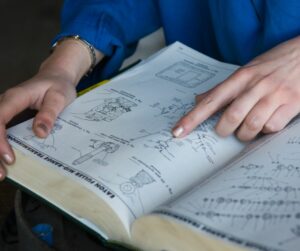The Challenges of Technical and Scientific Translations
Translation, at the core, is how we convert content from the original or ‘source’ language to a target language. It’s crucial to preserve the meaning, style, and tone of the source language as we aim to make the content accessible in target languages and take cultural nuances and context into account.
Zooming in on technical and scientific translations, – which are often considered and referred to interchangeably – we can acknowledge that they both are some of the most complex types of translation and do require subject matter experts in their specific field. However, technical and scientific translation can be set apart with some distinct features that we will take a closer look at in this blog post.
What is Technical Translation?
 Technical translation is the translation of specialised documents, such as manuals, user guides, product specifications or spec sheets, which can often be found in the field of engineering, medicine, and information technology (IT). The goal of translating technical texts can be communicating among professionals or specialists within the industry or making important documents more accessible for end users or the general public.
Technical translation is the translation of specialised documents, such as manuals, user guides, product specifications or spec sheets, which can often be found in the field of engineering, medicine, and information technology (IT). The goal of translating technical texts can be communicating among professionals or specialists within the industry or making important documents more accessible for end users or the general public.
For instance, a company that manufactures industrial equipment need to have their spec sheets and product manuals translated into multiple languages for its international customers. Another example would be for a home appliance manufacturer to translate user manuals and instructions as they expand into foreign markets. As such, experienced technical translators with a background in a specific field would be able to accurately translate technical jargon and terminology between the language pair.
What is Scientific Translation?
A scientific translation is technical in ways that it dives deeper into complex terminology and concepts, which are predominantly used in research papers and journal or academic articles. Scientific text can include complex theories, terms, graphs, tables, and other visual elements that demand a deep understanding of theoretical background in the area of, for example, biology, medicine, pharmacology, and other disciplines related to life sciences.
Apart from scientific documents mentioned above, scientific translation also encompasses clinical or laboratory trials, research proposals, and funding applications. In some cases, scientific translators may even have to work closely with the researchers or authors of the source content themselves to ensure the complete accuracy and precision of translated documents, e.g. quantitative research findings or results of clinical trials.
The COVID-19 pandemic is an excellent example of how scientific translation plays a vital role in disseminating information among health professionals and the general public. For instance, after the Pfizer-BioNTech and Moderna COVID-19 vaccines were approved for emergency use in the United States, the scientific community needed to rely on accurate and timely scientific translations to better understand the clinical trial data and how the vaccines work. Scientific translators were able to provide translations of the clinical trial protocols and data, allowing researchers and healthcare professionals around the world to review and analyse the findings.
 Overall, the goal of scientific translation is to disseminate findings or results, share data, and complement the body of knowledge in other languages, which can eventually lead to progress in science and humanity at large.
Overall, the goal of scientific translation is to disseminate findings or results, share data, and complement the body of knowledge in other languages, which can eventually lead to progress in science and humanity at large.
Scientific Translation vs Technical Translation
In the simplest of terms, scientific translation is a branch or subset of technical translation. While both require subject matter expertise, translating scientific texts focuses on the precision and correctness of scientific terminology and concepts. On the contrary, technical texts emphasise the clarity of technical specifications and practical applications and usability.
Since English is the dominant lingua franca of science, a broader audience with a different mother tongue may find it challenging to access and fully comprehend the body of knowledge. Therefore, scientific translation enables the global dissemination of knowledge and breakthroughs, resulting in new collaborations, cross-cultural insights, and advancements.
Structure of Scientific Papers
A majority of published journal articles follow a standard structure called IMRaD which stands for Introduction, Methods, Results, and Discussion. Not only do researchers or authors write their manuscripts according to the IMRaD structure, but readers of scientific articles themselves are also accustomed to this very structure and understand how each section functions or simply put, where to find what they specifically look for.
IMRaD Structure
- Introduction: This first section gives readers a background of the study, e.g. research problem and objectives. It also outlines the structure of the paper.
- Literature Review: While literature review is absent from the IMRaD as it may be considered a part of the introduction, this section is central to the study itself as it identifies the research gap, addresses research question(s) (RQ), and sets the context or positions the area of the study.
- Methodology: This study explains the research design, data collection (e.g. qualitative or quantitative), data analysis, and ethical considerations if needed.
- Results: Findings of the study are presented in this section with tables, graphs, numbers, and other statistical analyses without interpretation or discussion.
- Discussion: This final section is where the findings are interpreted, discussed, and explained based on previous research. It also proposes avenues for further study.
All scientific and academic articles must include a reference or bibliography section arranged alphabetically and formatted according to the citation style used.
How to Translate Scientific Papers
Familiarise yourself with the subject matter
Before any type of translation, you must have a solid understanding of the subject, especially with scientific translation which requires a particular set of skills and knowledge that not all translators possess.
 Read the entire paper
Read the entire paper
You might get away with translating general content without going through it first, but certainly not with scientific research. Reading the whole article lets you gauge your understanding and identify any potential challenges or areas that may require special attention.
Identify key terms, theories, or concepts
When going through the paper, take note of theoretical or conceptual frameworks and keywords that appear repeatedly. Research any unfamiliar terminology to ensure you understand them thoroughly.
Consider the target audience
Who will be reading the translated version of this scientific content? The language and tone used should be appropriate for the intended readership, which may be other scientists, researchers, or the general public.
Translate and maintain consistency
Now, you should be ready to translate. Pay close attention to grammar, syntax, and punctuation. Use the same terminology and wording throughout the document, and avoid unnecessary or overly complicated phrasing. Keep in mind that scientific translations deliver precision and correctness, so you don’t need to be creative.
Check formatting and visual aids
Scientific papers often contain charts, graphs, and other visual aids. Make sure that these elements are properly translated and formatted, and that they are consistent with the original paper.
Proofread and edit carefully
The first draft is never final. Proofreading and editing are key to ensuring the accuracy and readability of any translation and, in some cases, regulatory requirements and compliance. Review the translation multiple times, and have it checked by professional translators if possible.
Translating Technical Documents
Understand the terminology and jargon
The first step in translating technical documents is to understand the terminology and jargon used in the document. This requires knowledge of the technical field, as well as familiarity with the specific terms used in that field. You must research and understand the technical jargon used in the document before starting the translation process.
 Be consistent with the terminology
Be consistent with the terminology
As technical language includes specialised jargon that has specific meanings in the context of the document, inconsistency can lead to confusion, misinterpretation, and errors in the translated document. The translator should create a glossary of technical terms that lists the source language term, the target language equivalent, and any relevant notes or context.
Collaborate with subject matter experts
Collaborating with subject matter experts is crucial to ensure the accuracy and clarity of the translated technical documents. Language experts can provide insight into the technical content. As a result, the translation will be consistent with the terminology.
Proofread and edit
Proofreading and editing are essential steps in any translation project. You must review the translated document for accuracy, clarity, and consistency with the original document. This process should be done by a skilled linguist with knowledge of the technical field and experience in translating technical documents.
The Bottom Line
While scientific and technical translations may seem similar at first glance, they are in fact distinct disciplines that require different skills and expertise. Whether you need to translate a scientific paper, a technical manual for a piece of machinery, or any other type of specialised document, working with an experienced translator who specialises in the appropriate field is essential.
Scientific translation requires much more than just a translation from language A to language B. The translation of scientific texts must be carried out carefully to leave no room for error, especially for numbers, graphs, charts, and other visual elements that demand as much attention as the body text. Besides, as scientific texts come with unique terminologies and linguistic nuances, translators should understand the structure of scientific articles to translate and maintain the consistency and tone of the original text.
 Scientific translation ultimately plays a key role in disseminating knowledge and findings that help make science progress and, in some cases, save millions of lives across the globe. Thus, using professional translators with experience and expertise in scientific translations can ensure that the translations are both accurate and precise.
Scientific translation ultimately plays a key role in disseminating knowledge and findings that help make science progress and, in some cases, save millions of lives across the globe. Thus, using professional translators with experience and expertise in scientific translations can ensure that the translations are both accurate and precise.
Though English still dominates the world of science and research, the language shouldn’t be a barrier to scientific progress. In this way, scientific translation services can provide a high-quality translation that meets the needs of the intended audience. With the right approach and the right team in place, you can be confident that your translations will be accurate, effective, and engaging for your readers.
At My Language Connection, we specialise in scientific translation services that match your industry-specific requirements. With a set of skills and knowledge in their particular field, our qualified subject matter experts ensure accurate and precise translations of all your scientific documents. Request a quote today.

